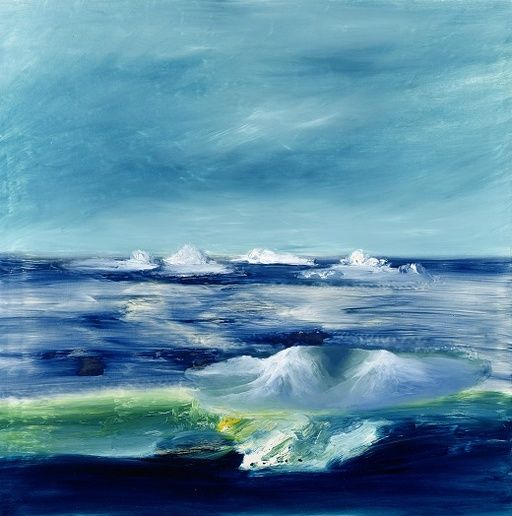

Icebergs, 1964
Sidney Nolan, Icebergs McMurdo Sound, Antarctica), 1964, oil on board, 122 x 122 cm, © Sidney Nolan Trust. Private Collection
Laurence Hall is Manager of Audio Visual Service at Art Gallery of New South Wales.
"Still images, film and video recordings provide a glimpse into the past. Through digital video I have seen Sidney Nolan at the Rodd, masked up wielding spray cans and working the paint surface with his hands, demonstrating a use of techniques and tools beyond those of a more traditional painter. Clearly Nolan’s commercial and industrial background provided the foundations for a practice that took full advantage of technical innovations.
My work with audio visual media enabled me to view a number of video files featuring Sidney Nolan. Seeing his method added a dimension to my appreciation of his landscape works. Nolan’s casual ease of technique, the incorporation of a wide range of paint innovations and his ready adoption of spray cans in the 1980s was revelatory. It was a genuine transformative process for my appreciation of his paintings. In some segments, Nolan had a spray can in each hand, targeting distinct areas of the canvas, overlapping the paint sprays where he intended and occasionally reaching into the painting with a hand or a brush to blend, mix or develop a feature.
From a technical perspective, Nolan the Painter was very much a man of his time.
As with his other works, Sidney Nolan's Antarctica paintings are a product of his willingness to engage with the latest developments of the paint industry. Nolan's expertise and resourcefulness resulted in the generation a unique style of landscape which captures an essence rather than aspires to direct likeness.
As is so often the case when learning about Sidney Nolan’s life and practice, researching the Antarctica paintings yielded surprising results. I was astonished to learn of the volume of paintings the Antarctica trip engendered. Nolan travelled to Antarctica in the January of 1964. After 8 days spent on the ice and flying over the area by helicopter, he was in Australia by February. He travelled from Sydney to Adelaide for the Adelaide Arts Festival and was in London by April.
April in London was Nolan’s first opportunity to use a new medium – an alkyd gel additive which promoted rapid paint drying. It seems likely this allowed him to work so quickly: By the September of 1964 Sidney Nolan had completed 60 Antarctica paintings, including Icebergs (McMurdo Sound Antarctica), 1964 and had painted over 50 of the Adelaide Ladies series as well.
Icebergs (McMurdo Sound Antarctica), 1964 is possibly the most haunting of Sidney Nolan’s Antarctic paintings. It is a seascape punctuated with ice, a work that steps away from other landscape paintings and borders on dreamscape. The sky of Antarctic light manifests colour effects reflected and refracted by ice crystals and the optics of compressed and ancient ice flows. The berg in the foreground looks an unlikely object, yet it becomes something else when married to the green luminosity of its surroundings.
The entire scene is lit by a sky without sun. Ice, air and water glow beneath a sky that is almost lour. With nothing to provide scale we see a seascape which may be on the verge of storm or may be a frozen moment of calm.
Icebergs (McMurdo Sound Antarctica), 1964 embodies a tension that is visible in the dried paint surface. Some paint layers combine whilst others reject each other or form almost uneasy alliances. Antithetical paints are disciplined to mix, forming a texture which favours his goal for a view of ice in sunlight, frozen mountains on a turgid sea and all beneath a sky that stands on an ambiguous edge, paused in a moment of calm, a polar dawn, a dusk, or the eye of a storm. It is an essence of ice and sea in a place where weather is all of life and death and the elemental."